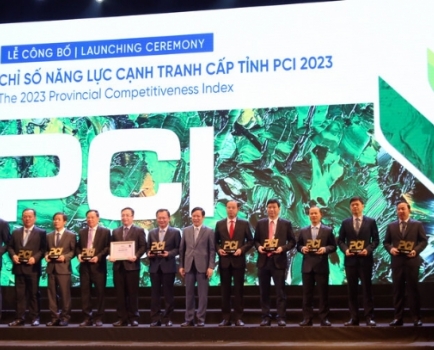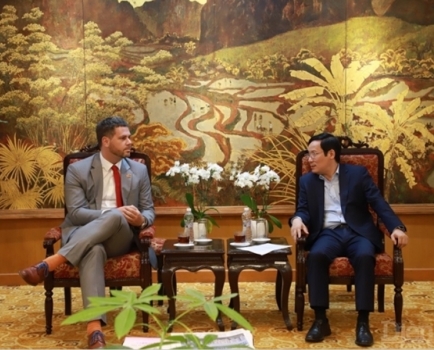Linking the Development of the Eastern Expressway Industrial Zone
Mon, 11 Sep 2023 09:07:00 | Print | Email Share:
Forum: The development linkage of industrial zones along the Eastern Expressway is directed by the VCCI and the People's Committee of Hai Phong City. The Business Forum Magazine and the Hai Phong Department of Planning and Investment organized it on August 31, 2023, in Hai Phong City.
Considered as the nucleus of the Northern Key Economic Region, the four localities along the Eastern Expressway (Hung Yen, Hai Duong, Hai Phong, Quang Ninh) all have strengths in industrial development. However, development still follows the 'each to their own' pattern, lacking connectivity.

VEHEC Council - The Governing Body for the Implementation of the Eastern Expressway Economic Connection Agreement.
The localities including Hanoi, Hai Duong, Hung Yen, Hai Phong, and Quang Ninh are situated along the expressway connecting Hanoi - Hai Phong - Mong Cai. Hanoi, Hai Phong, and Quang Ninh are the three growth poles in the economic development triangle of the region.
Issues Raised:
(1) Comprehensive planning for industrial zone (IZ) development and economic zones (EZ) lacks a long-term, holistic vision in relation to other economic sectors and society, and is not aligned with sectoral planning or the overall socio-economic development plans of the region and the country. Regional connectivity remains weak.
(2) Forecasting work for planning has several shortcomings leading to multiple revisions of plans. The occupancy rate of many industrial zones is relatively low, and many IZs face slow implementation.
(3) The industrial zone development model has been slow to evolve, primarily focusing on simple industrial concentration, labor, and production spaces, with insufficient emphasis on improving living and recreational spaces for workers. Some IZs still face many difficulties, especially in terms of housing and social services.
(4) Infrastructure planning for industrial zones does not fully consider technical infrastructure and social infrastructure beyond the fence. In some areas, industrial zones are primarily concentrated along national highways, leading to local overload issues affecting the daily lives of local residents.
(5) Most industrial zones mainly develop with a multi-sector, multi-field approach, with the primary goal being to increase occupancy rates. Compliance with environmental regulations and technology requirements is lax, and the transition to advanced IZ development models is slow.
(6) There is a lack of unity and even fragmentation in the management and investment responsibilities among ministries, sectors, and localities in terms of the types of IZs, EZs, export processing zones, high-tech zones, industrial clusters, and local authorities in ensuring the living and working conditions for the labor force.
Recommendations for Solutions:
The results of the review of industrial zone (IZ) planning have shown that alongside the existing challenges in IZ planning and management at the national level, there are also certain issues in the planning and development of IZs in the four provinces and cities:
(1) Despite being a key industrial region in the country, the pace of IZ development is slow, the occupancy rate of many IZs is low, and the capacity to provide industrial services and technical infrastructure in some IZs is limited.
(2) Most IZs face difficulties in attracting large, professional investors and lack proactiveness in attracting secondary investors.
(3) The concentration of industries in attracting investments, with similar national strategies, has reduced their attractiveness and competitiveness.
In the expected period from 2021 to 2030, there will be a total of 139 IZs in the four provinces and cities, with an additional 60 IZs. The total area of these IZs will be 59,441 hectares, an increase of 23,930 hectares. The current status of IZs in actual operation is 15,913 hectares, with an occupancy rate of 50.45%, meaning that the actual area of IZs put into production is 8,028 hectares.
This poses a significant challenge in organizing the implementation of planning to ensure effective utilization of land resources. In addition, specific labor resources and infrastructure conditions need to be identified to contribute to the efficiency of investment in IZs.
The requirement to transition the development model of IZs from the current model to specialized IZs, eco-industrial parks, and urban IZs is an inevitable direction. However, the transition process not only requires time and funding but also demands a change in the mindset of IZ development planning. The state also needs clear regulations for the transition process to ensure fairness and sustainable development in the future.
It is essential to promptly refine the legal system to ensure consistency and unity in the management and investment responsibilities among ministries, sectors, and localities regarding the types of IZs, economic zones, export processing zones, high-tech zones, and industrial clusters.
Mr. Tran Tien Dung, Member of the Executive Committee of the Vietnam Logistics Association (VLA), Chairman of the Hai Phong Logistics Association: Promoting the flow of goods in industrial zones.
Although the infrastructure of economic zones, industrial zones, and border gate areas is conveniently interconnected with each other and with modern highway systems, according to a VLI survey in 2022, it was found that only 50% of businesses choose road transport for agricultural and aquatic products (the main export items to China). This means that many enterprises do not choose road transport as the method of transportation for exporting agricultural and aquatic products.
This indicates that logistics services serving the export of goods, especially agricultural and aquatic products, by road still do not meet the demand and require more attention and investment.
Through an assessment of potential logistics service areas in the Hanoi - Hai Phong - Quang Ninh Economic Triangle, VLA/VLI proposes to leverage the connectivity of the Eastern Expressway, including the Hanoi - Hai Phong Expressway, Hai Phong - Ha Long Expressway, Ha Long - Van Don Expressway, Van Don - Mong Cai Expressway, to focus on developing logistics services such as e-commerce logistics, cross-border logistics, seaport logistics, and tourism logistics. To develop these services, initial attention should be given to investing in infrastructure for seaport logistics, cold storage systems for agricultural products, and warehouse and logistics centers at border gate areas.
Mr. Nguyen Trung Kien, Head of the Management Board of Industrial Zones in Hai Duong Province, emphasized the importance of enhancing the effectiveness of the "one-stop, one-gateway" role.
To harness the strengths of each locality and sector, in terms of policy mechanisms, there is a need to continue advising the Ministry of Planning and Investment on establishing a regional linkage mechanism for the Northern Key Economic Region, linking the Eastern Expressway in the Scheme for Regional Linkage in Vietnam from 2021 to 2030 submitted to the Prime Minister for approval.
The Ministry of Planning and Investment should supplement the Industrial Zone and Economic Zone Law project to provide the highest legal framework to enhance effectiveness, efficiency, and consistency in planning, investment, construction, and operation of industrial zones, economic zones, and border gate economic zones in a decentralized manner, assigning direct tasks to the Management Boards for comprehensive state management of industrial zones, economic zones, and border gate economic zones. Ministries and sectors should actively delegate authority to the Management Boards to carry out specialized state management tasks, ensuring the effective role of the "one-stop, one-window" approach.
To improve the effectiveness of infrastructure development in industrial zones, it is necessary to develop a plan for the development of industrial zones and economic zones for the period 2021 - 2030, with a vision to 2050. This plan should specify the number, area, and implementation schedule of industrial zones and economic zones, while leveraging the influence of resources and strengths of neighboring regions. Each locality should enhance training and human resource development. Each locality should also engage in sharing and networking to promote investment, in order to attract investments to industrial zones.
Mr. Bruno Jaspaert, General Director of DEEP C Industrial Complex, emphasized the need to eliminate barriers to the development of eco-industrial zones.
Developing eco-industrial zones is currently a new direction for industrial zones to attract secondary investors. To promote the transition towards zero emissions by 2050, DEEP C hopes for strong support from both central and local authorities to encourage the active participation of the private sector and establish a clear and comprehensive legal framework.
In particular, there should be guidelines and policies that create favorable conditions for industrial zones to implement renewable energy development initiatives smoothly. Nowadays, many provinces and cities still oppose the establishment of independent electricity distribution companies by industrial zones; therefore, there should be clearer guidance on this issue.
In addition to ongoing rooftop solar and wind power projects, DEEP C is actively exploring the potential for offshore wind power projects, energy storage, biomass, LNG, and solar energy production at closed landfill sites. DEEP C hopes to receive support from both central and local authorities for these efforts.
We particularly look forward to obtaining approval to conduct a feasibility study and research report for a solar power project at the Dinh Vu landfill area. This project will not only provide electricity for DEEP C Industrial Complex but also offer comprehensive solutions for the remediation of the polluted landfill site.
Mr. Pham Hong Diep, Investor of Nam Cau Kien Industrial Zone, emphasized the importance of developing land reserves for infrastructure development in industrial zones.
One of the critical bottlenecks in the development of industrial zone infrastructure in Hai Phong City, as well as in the whole country, is the difficulty that infrastructure investors face when accessing land reserves for industrial infrastructure development.
Currently, provinces and cities lack allocated land targets for industrial zones. The procedures for preparing investment projects for industrial zone infrastructure take a considerable amount of time, averaging from 4 to 5 years, with 7 steps ranging from planning to obtaining investment approval and construction permits.
Issues related to land procedures, such as land compensation and resettlement, land use conversion, land allocation, land leasing, and land use rights certificates, are also matters of concern for businesses.
However, with the current lack of precise land laws and policies, investors are exposed to significant risks. Many industrial zone projects and investors have completed land compensation and resettlement procedures, invested in infrastructure, but have not yet signed land lease contracts with the state, leading to projects being abandoned and causing the wastage of billions of Vietnamese dong.
The National Assembly is about to pass various legal bills, especially the Land Law (amended), which needs to be closely aligned with the practical situation, reflecting the realities of life, and contributing to creating a more transparent mechanism for investors to easily access land reserves for their projects.
According to the Business Forum Magazine.
By: Translator: LeAnh-Bizic
---------------------------------------------
Same category News :













